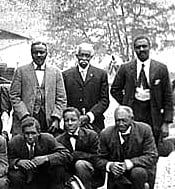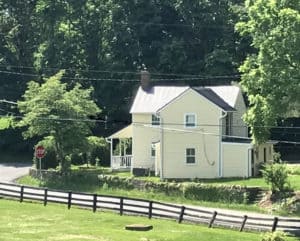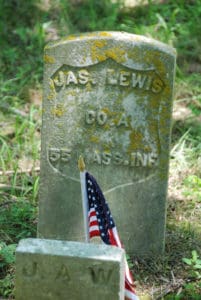James Lewis 1844-1910+
Waterford was one of only two districts in Loudoun to vote overwhelmingly against secession, but when Virginia left the Union, several Waterford men fought under the Confederate stars and bars. Early in the war black Americans were not eligible to become soldiers, but as soon as black soldiers were approved to join the U.S. military, thousands flocked to enlistment stations. Teenage James Lewis (not to be confused with the James Lewis born c.1800 who owned 15655 High Street) from Waterford was one of them, and he enlisted in the 55th Massachusetts Infantry. From 1863 he served further south on the battlefields and picket lines of Florida and South Carolina. At least seven other enslaved or freeborn black Americans from Waterford enlisted with the Union Army, either with state outfits like the 54th and 55th Massachusetts, or with the nation’s first U.S. Colored Troops regiments. After the war many southern black soldiers settled in Ohio, New York, or even Texas, but James Lewis came home to Virginia.
James Lewis returned to Waterford, married and built a small house in 1877 on Butchers Row. Butchers Row takes its name from a slaughterhouse that stood between this house and the Mahlon Myers House. The has a two-story, two-room plan with a service addition. Lewis himself built the stone wall, inspired by that of his employer at 15606 Second Street.
He was a pillar of his church and was respected by those who knew him. One who knew him well, Quaker Lewis Walker has left the following remembrance - and unintended insight into racial relations in the village in the late 1800s
I want to pay tribute to Jim Lewis who worked for Father [J. Edward Walker] faithfully after moving to Waterford. He had been a slave and he told me he carried a welt on his back from boyhood when he had been flogged. He took care of all the outside work including a fine garden and in winter, looked after the fires, and did errands. He made an open fire in Father's bedroom each cool morning after Mother died, usually before Father was up.
Father at one time had built a very nice retaining wall in front of his property [15606 Second Street] and a little later he as interested to see that Jim, without having mentioned it had the same kind of a wall around his property, which was located at the junction of the two roads leading to our Meeting House. He always addressed me as Mr. Lewis and some old colored men of the community tipped their hats to me when meeting me in the street after I had been away to school.
By the turn of the century James Lewis was an old man. His wife Mary passed away in 1901, but James remained at his two story home on Butcher’s Row. James left no account of his life or his military service, it’s possible he never learned to read or write. However, his handiwork as a stonemason is evident throughout the village. Both the stone wall next to his home and the stone foundation of the John Wesley African Methodist Episcopal church were built with his hands. It’s unknown how many other homes, shops, or walls were laid by James Lewis in Waterford and the surrounding area.
Lewis passed away sometime after 1910. James Lewis’ small but proud headstone reminds us of Virginia’s sons who served their country and community during enslavement and into freedom.
[Provided by seeitsaveit.home.blog.]


